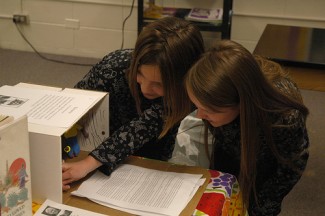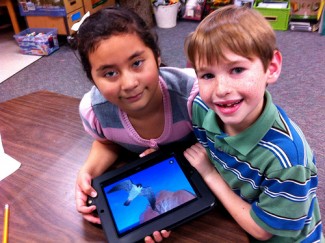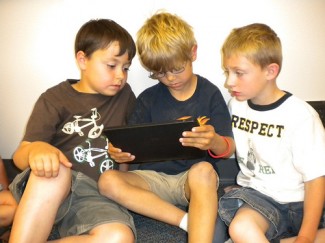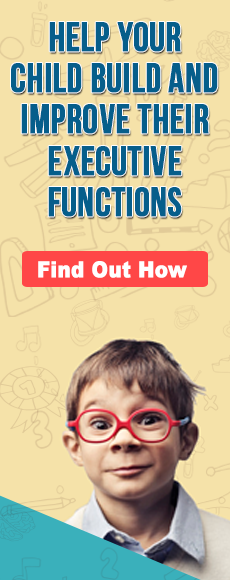Overview
 Our idea of Flexibility is derived directly from the Flexibility executive function. This Thinking Skill focuses on a student’s ability to be adaptable, to improvise, and to shift approaches to meet different kinds of challenges. For example, a student with strong Flexibility skills will easily adapt to a change in the classroom routine, such as a seat change or schedule interruption. A student who struggles with Flexibility may have a hard time adjusting to these changes, which can often impact classroom performance.
Our idea of Flexibility is derived directly from the Flexibility executive function. This Thinking Skill focuses on a student’s ability to be adaptable, to improvise, and to shift approaches to meet different kinds of challenges. For example, a student with strong Flexibility skills will easily adapt to a change in the classroom routine, such as a seat change or schedule interruption. A student who struggles with Flexibility may have a hard time adjusting to these changes, which can often impact classroom performance.
Flexibility is also important for academic success in different subject areas. For example, students need to be flexible when editing or revising written work. They also need to be able to adjust their thinking and use different problem solving strategies in math. In social studies, they might need to shift perspectives when learning about new cultures. Also in science, students typically have to be flexible when their orginal hypothesis does not stand up to the results of an experiment.
Click here for more Flexibility Fundamentals.
Flexibility Skills in the Classroom
 Students need to use Flexibility skills in order to meet with success in the classroom. The following list outlines some common classroom tasks that require the use of Flexibility skills:
Students need to use Flexibility skills in order to meet with success in the classroom. The following list outlines some common classroom tasks that require the use of Flexibility skills:
- Transitioning between activities, classes, or subjects: Students need to be able to adjust their mindsets, switch materials, and often move to a different location when transitioning from one activity to the next. Flexible thinking is required in order to successfully adapt to these changes.
- Accepting mistakes and moving on: In order to successfully participate in many classroom activities, students need to be able to accept mistakes and move on without becoming distracted and dwelling on the mistake. Similarly, when one problem solving strategy does not work, students need to be flexible and willing to move on and try something new.
- Collaborating successfully with peers: Students need to use flexible thinking to be able to understand others’ perspectives and ideas when working in a group. Effective collaboration often involves compromise, and students need to be able to work with others’ ideas instead of rigidly insisting things be done their way only.
- Adapting to new teachers, subjects, activities, students, or schedules: There are many changes that students can experience in a classroom, like the arrival of a new student, disruption to the regular schedule due to a school-wide assembly, or beginning a new reading group. Students need to be able to adapt to these new situations so they can remain engaged in classroom activities instead of becoming distracted by changes.
 Teaching Flexibility Skills with Digital Media
Teaching Flexibility Skills with Digital Media
Flexible problem-solving is routinely required for mastering digital technologies and games. When students are introduced to new technology, such as a smart phone, they explore it in order to figure out how it works. They may push different buttons, make mistakes, and figure out how to get the desired results. Classroom blogging websites and other technologies built to be cutomized by the user allow for students to explore many options and use flexible thinking while expanding their interests.
Success in gaming requires an understanding that the rules may change, requiring many different strategies to “beat” the game. In gameplay, children often need to shift from a strategy that worked earlier in a game to a more complex or different approach in later phases of the game. The capacity to reevaluate the use of a game-based strategy in a rapid fashion (e.g., collecting coins, building ladders, simultaneously running and jumping) from one game situation to another is crucial for success. Similarly, the recognition that one must make and learn from one’s mistakes is often a key component to video game mastery. Learn more about how digital game play can help develop Flexibility Skills.
Check out our classroom guides for information on how to use specific games and digital technologies to teach Flexibility skills.
Alternative Learning Concerns & Flexibility
 Building Flexibility skills can be particularly challenging for some Alternative Learners. Many of these students need explicit instruction on how to use Flexibility skills, as well as practice using these skills in a variety of contexts. Our Classroom Guides provide teachers with ideas on how to integrate digital media into instruction in a meaningful and fun way that can help Alternative Learners work on their Flexibility skills.
Building Flexibility skills can be particularly challenging for some Alternative Learners. Many of these students need explicit instruction on how to use Flexibility skills, as well as practice using these skills in a variety of contexts. Our Classroom Guides provide teachers with ideas on how to integrate digital media into instruction in a meaningful and fun way that can help Alternative Learners work on their Flexibility skills.
ASD & Flexibility
Students who are diagnosed with Autistic Spectrum Disorders often struggle with classroom tasks that require flexible thinking. Some tasks that may seem routine can be very challenging for these students, such as changing partners, moving seats, or a change in the daily schedule. It is also not uncommon for these students to have difficulty working in cooperative groups when they need to compromise and use flexible thinking to incorporate others’ ideas. Additionally, these students may have trouble with more academic tasks that require flexibility, causing their performance to suffer. For example, students with Autistic Spectrum Disorders can sometimes shut down when they are asked to make revisions to a written assignment or go back and try a new math strategy.
Digital technologies can be excellent tools for teachers to use with students with Autistic Spectrum Disorders to build Flexibility skills. Many video games, by nature, require a lot of trial and error learning and flexible thinking. Students have to make mistakes and change approaches frequently, which can help students with ASD to learn to handle this kind of shift in thinking. Using digital media in the classroom can also be a way for students with ASD to engage with their peers in a structured, guided way.
Anxiety/Depression & Flexibility
Using Flexibility skills in the classroom can also be a struggle for students diagnosed with anxiety and/or depression. These students may become overwhelmed or anxious as a result of changes in the daily routine or working with a new group of people. These students may also have trouble with different academic tasks, such as accepting teacher feedback and applying it to their work. Some students with anxiety and/or depression tend to focus only on negative aspects of feedback from teachers or peers, and can become “stuck” instead of moving forward on an assignment.
One reason video games and other digital technologies can be beneficial teaching tools for students with anxiety and/or depression is because they allow students to make mistakes in a safe place, without fear of being singled out or criticized. Students make mistakes all the time when playing games, and they are able to learn from those mistakes and readjust their approaches accordingly. The relief that many of these students often feel when using digital media may also help them feel more comfortable participating with their peers in classroom activities involving video games or other technologies.
Behavioral Problems & Flexibility
Students with behavioral problems may also have trouble using Flexibility in different settings. They may become easily angered or upset when something does not go the way they wanted it to, or when they are asked to use flexible thinking to compromise with others. They may also have difficulty making appropriate choices and can become very rigid in their thinking when they are not happy with the choices in front of them. They may also have trouble accepting consequences for their actions and shifting from a negative attitude to a more positive one.
Using digital media in the classroom can be a great way for teachers to keep students with behavioral problems engaged in instruction. Video games and other digital technologies can help students with behavioral problems practice Flexibility skills and help with cope with negative emotions and frustrations. Many video games provide students with clear and immediate feedback when they make an incorrect choice, and students with behavioral problems often benefit from that kind of direct feedback.
LD & Flexibility
Students with Learning Disabilities can also struggle with Flexibility in a variety of ways. All students learn in different ways, and the difficulties faced by students with Learning Disabilities will vary based on the students’ individual learning profiles. Some students might struggle to use Flexibility when trying to solve a math problem and use the same formula over and over again, even though it is not giving them the desired result. Other students may have a hard time using flexible thinking to write a paragraph from the point of a view of a character in a book.
Incorporating digital media in the classroom provides many opportunities for differentiation in order to meet the needs of all students, and to help build Flexibility skills. Our Classroom Guides are great tools to use for teachers of students with Learning Disabilities because they are adaptable, meaning teachers can decide how best to use them based on the individual needs of the students.
Educators Guide to the Executive-Functioning Skill of Flexibility
Flexibility is the capacity to switch one’s thinking based upon the demands of a situation and adapt one’s emotional response due to changes and transitions in one’s environment. Flexibility encompasses the ability to improvise, shift from one approach to another, and adapt to the demands of a situation. Flexibility also requires the capacity to create novel strategies and shift one’s attention from one task to another. The use of flexibility necessitates the recognition of the need to utilize different problem-solving strategies and take reflective, careful approaches based on previous attempts. Cognitive and emotional flexibility help children to find effective problem-solving strategies and deal with uncertainty. Flexibility helps children transition from one activity to another and deal with new or different situations.
Flexibility involves the capacity to improvise, shift approaches, and be adaptable to the demands of a situation. It requires the development of novel strategies and the ability to shift attention from one task to another. Recognition of the need to utilize different problem-solving strategies, including reflective, careful approaches or a trial-and-error/random approach, is another aspect of flexibility.
Flexibility is often utilized in social situations and in dealing with peers. It is an important part of a child’s ability to transition between activities. It helps them deal with disappointments and shifting expectations and cope with unexpected events and changes in routines.
How can I tell if a student is having trouble with Flexibility?
These descriptions might help you identify a student who is struggling with Flexibility in the classroom. Problems with Flexibility may be exacerbated by challenging academic demands but are likely to be present across situations. As with all of the Thinking Skills in the Playing Smarter curriculum, struggles with Flexibility are likely to co-occur in most students with other areas of weakness in their thinking skills.
All Students:
- Receiving constructive criticism
- Trying new activities or tasks
- Handling frustrations while attempting to complete a task
- Adjusting to a change in routine such as having a substitute teacher or a fire drill
Particularly Important for Elementary Students:
- Transitioning from one classroom activity to another
- Shifting from playing with friends at recess to going back to class
- Altering one’s behavior and work ethic appropriately when given instruction to do so rather than taking offense and having a temper tantrum
Particularly Important for Middle School Students:
- Adjusting to a new and challenging schedule such as block scheduling or A or B days
- Moving from one classroom to another classroom smoothly and efficiently
- Dealing appropriately with social frustrations such as not being able to sit with friends at lunch
When do students use Flexibility skills at school?
These are common school-based situations where the thinking skill of Flexibility is needed. The best way for students to learn the skill of Flexibility is to practice it while engaged in daily activities. Take the time to recognize these common situations and when you can encourage your students to employ and improve their Flexibility skills.
- When transitioning between classes or subjects
- When stopping work on one project and moving on to another
- When learning from mistakes in math and science
- When switching from trial-and-error learning to a more systematic approach
- When adjusting to new teachers, subjects, activities, changes in the schedule, or students in the classroom
- When switching approach between different subjects based on the demands of the content
- When adjusting to classroom transitions at the beginning of the school year
What tips can I give my students to help them improve their Flexibility skills?
- Try things that you haven’t done before (such as new foods, a new sport, or a new game) to practice being flexible.
- Relax and become more physically flexible. Learning to relax physically can help you to be less rigid about other things. Practice yoga stretches or try deep breathing techniques.
- Think about how much you have changed and all the new ways of thinking you have developed since you were younger. For example, if you were 12 you could consider how much you’ve matured and how your interests have changed since you were 9.
- Encourage your students to play games that are strictly chance such as flipping coins, playing “war” with a deck of cards, or any number of board games.
How can I help my students practice their Flexibility skills in the classroom?
- Practice trial-and-error learning. Do something with the students in which it is clear that there is no right or wrong answer. For example, rearrange the books on a bookshelf to see how they look best.
- Ask your students to help you learn how to use a new game or piece of software that you have just bought. Compliment the students’ willingness to make errors, try new things, and learn from their mistakes when engaged in this type of activity. Engage in a discussion of how this applies to many other things in their real worlds.
- Model making mistakes and the ability to laugh at yourself. When you make a silly mistake during class (such as confusing the day’s schedule), calmly point out your mistake and mention something positive about this mix-up. This can help students to grasp the unforeseen benefits of doing things differently. Your ability to laugh at your mistakes enhances Flexibility and demonstrates for the students your capacity not to take some things too seriously.
- Systematically and gradually expose students to new situations. Start with areas with which the students have a degree of familiarity or comfort. For example, encourage students to attend an after-school activity in which their friends are involved prior to suggesting they attend a homework club or extracurricular activity where they know no one.
Classroom Guides for Flexibility
[post_grid id=”95708″]




